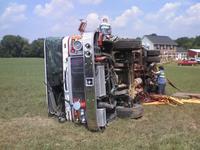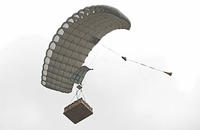-
Smart traffic system to reduce first responder deaths

Nearly 13 percent of the firefighters and police officers who die in the line of duty are killed in vehicle-related incidents, and fire trucks are involved in 10 times as many collisions as other heavy truck; University of Arizona researchers have teamed up with the Maricopa County Department of Transportation (MCDOT) to create a system that will make intersections safer for emergency responders and the general public
-
-
Madison County, IL receives $260,000 in DHS grants
Two fire departments in Madison County, Illinois were recently awarded more than $260,000 in federal grants; the grants come as part of DHS’ Assistance to Firefighters program and goes toward the purchase of new safety gear and firefighting equipment; the Wood River fire department will receive $223,556 to help pay for a high-volume foam monitor as well as foam that will be used to put out chemical fires; the Rosewood Heights Fire Protection District will receive $37,050 to procure thirty sets of new protective fire suits
-
-
Precision parachute system for pin-point delivery of sensitive loads

Military units often operate behind enemy lines, and disasters often sever transportation links; in both cases, the provision of supplies — military or humanitarian — is a major issue; now there is a solution; the manufacturer says that the precision air-cargo parachute — classified as a UAV becasue of its navigation capabilities — is the only commercially available system in the world that can ensure the pin-point delivery of sensitive mission equipment, humanitarian aid, and supplies fully automatically from the air without damage
-
-
Westland, MI firefighters receive federal grant for fitness program
Westland, Michigan firefighters recently received more than $100,000 from the federal government to fund a new wellness program; the health program is designed to help prevent on the job heart attacks, which is one of the primary causes of death among firefighters; roughly 100 firefighters die on the job each year, and heart attacks are responsible for 45 percent of those deaths, a higher percentage than other public safety occupations; Westland firefighters have also received $14,800 to upgrade its radio systems to comply with state-mandated standards
-
-
Japan facing a nuclear catastrophe

Initial estimates say that the Magnitude 9.0 earthquake and tsunami killed about 10,000 people and made hundreds of thousands homeless; Japan is facing another threat: radioactive contamination from four damaged nuclear power plants; the tremor damaged the cooling systems in the reactors, forcing the companies operating the plants to flood the reactors with corrosive sea water and boric acid; one containment vessel was destroyed in an explosion, and in order to prevent more explosion, radioactive-contaminated hydrogen had to be released, increasing the radioactive levels to unsafe levels; more than 200,000 people living in the vicinity of the reactors were evacuated; the government has began distributing iodine pills to citizens (the pills are used to protect the thyroid gland from the effects of radiation); the difficulties at the nuclear power plants mean that rotating power outages will be imposed across Japan as of Monday
-
-
A cautionary tale of local information sharing
Calhoun County, Alabama recently spent $850,000 on interagency communications equipment, but so far only one local police department uses it and the system is the source of significant tension among law enforcement officials across the county; poor communication, proprietary databases, and high costs have effectively prevented the county from creating an information sharing system for local law enforcement; each police department uses laptops tied to different servers with different information on them, and though each system was designed to share information, none of the departments’ databases can communicate with one another due to proprietary data and non-compatible physical infrastructure
-
-
Engineers use Xbox Kinect to find earthquake survivors
A team of engineers at the University of Warwick in the United Kingdom has been working to develop a robot capable of entering unstable buildings and searching for survivors, such as the 200 purportedly missing after the 6.3 magnitude earthquake in Christchurch, New Zealand; until now, technology has relied on expensive laser-based equipment, but Warwick’s team has reconfigured Microsoft’s Xbox Kinect to identify places in which survivors may be
-
-
Alabama fire departments receive more than $1.5 million in DHS grants
The Lanier Volunteer Fire Department in Talladega County, Alabama just announced that it received a little over $100,000 from DHS through its assistance to firefighters grant program; the department’s chief Jerry Alfred said he plans to use the funds to purchase a rescue truck; several other local fire departments also received grants from DHS including the Sycamore Volunteer Fire Department which received $231,750 and the Oak Grove Volunteer Fire Department which got $185,250; DHS plans to award $1,564,732 to eighteen fire departments throughout Alabama
-
-
Police uneasy about cheap smart-phone scanner app
Just a few years ago, someone wanting to listen to the dispatches of their local police department had to purchase and program special equipment; now, modern technology has made it possible to transform popular smart phones into personal police scanners; police say that criminals could use the increased accessibility provided by the new technologies as a tool for committing crimes
-
-
Mobile emergency detection app for Android phones
DefenCall smart phone app for Android users will be released in the second quarter; in the event of an emergency, users can tap on the app and it will automatically call, send text messages, e-mail any number of people that the user designates; the app will send the user’s name, contact information, and GPS location in addition to contacting first responders; DefenCall is currently being marketed to students on college campuses, those with chronic medical conditions, and travelers; the app costs roughly seventeen cents per day
-
-
Free radiation monitors handed out in South Carolina
Ionizing radiation, the most energetic form, is capable of removing electrons from atoms and damaging the DNA within living cells; widespread panic caused by a dirty bomb, small nuclear device, or nuclear fallout would leave people questioning whether or not they were exposed to a lethal dose of ionizing radiation; the RadSticker is an inexpensive citizen’s dosimeter which could minimize panic in the event of a radiological incident
-
-
Colorado education dept. to fund emergency comm. systems
Colorado will use a $41.5 million fund tied to the National School Lunch Act could be used to purchase emergency communications systems; the technology will improve communication between schools and first responders during an emergency
-
-
Oregon’s new budget may kill interoperability system
The goal of the $600 million Oregon Wireless Interoperability Network (OWIN) project is to design and construct a reliable public safety radio system for emergency responders, comply with the FCC’s 2013 deadline to transition state radios, consolidate four existing independent state radio systems, and create a network that all public safety radio users in Oregon can access; the governor proposes to halt the project for lack of money
-
-
N.J. county to purchase mobile morgue with DHS grant
Burlington County, New Jersey officials plan to use this year’s DHS grant of $775,000 to purchase surveillance for the county’s radio communications towers, license plate readers, and a mobile morgue unit capable of transporting eight bodies; the mobile morgue is used to provide morgue support in a mass fatality event
-
-
China's new water cannon is powered by a jet engine
The Chinese city of Luoyang has paid $456,000 for a jet engine powered water cannon; the cannon, designed for fighting high-rise fires, is capable of spraying four tons of water per minute — fast enough to separate fires from their oxygen supply
-
More headlines
The long view
Using Drone Swarms to Fight Forest Fires
Forest fires are becoming increasingly catastrophic across the world, accelerated by climate change. Researchers are using multiple swarms of drones to tackle natural disasters like forest fires.
